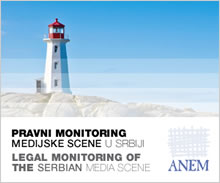30. 06. 2012
THE SIXTH ANEM MONITORING PUBLICATION
The Sixth issue of the specialized ANEM Publication "Legal Monitoring of Serbian Media Scene" contains the following:
- Introduction (with summary of results of legal monitoring of the media scene in Serbia in the first half of 2012, with brief overview of the Publication's contents),
4 expert authors' texts:
- Media coverage of elections - author: Slobodan Kremenjak, attorney at law (how and to what extent has the election process in Serbia affected the freedom of expression and media freedom; how had the media reported in the election campaign; what had affected their reporting; to what extent had the RBA Instructions helped (or not) the work of journalists and media during the election campaign; why the absence of general supervision over electoral process has been bad for media, particularly in the context of political counter-campaign)
- The first nine months of the Media Strategy - author: Kruna Savovic, attorney at law (to what extent has the Media Strategy been implemented; which pre-drafts of media laws have been produced and how; which solutions contained in the Media Strategy should have been implemented in this period and whether it has been done)
- Pre-draft Law on Electronic Media - improving regulation and practice - author: Prof. Rade Veljanovski, PhD, Faculty of Political Sciences in Belgrade (what is contained in this Pre-draft; which solutions are important; what are the improvements comparing to the Broadcasting Law; which provisions from the AVMS Directive have been included in the Pre-draft; why this Pre-draft serves as a basis for improvement of media regulation and practice)
- Post-communist media reforms from a bird's eye view - author: Jovanka Matic, PhD, Institute of Social Sciences in Belgrade (why are the changes to the media system seen as disappointing in post-communist societies; why the initial optimistic belief, that media will be efficiently fulfilling their role in a democratization of the society in transition, has proven to be utterly unrealistic; whether the position of the media in relation to the institutions of power have been changed; whether there is sufficient political diversity in pluralistic media systems and new democracies; why the media reforms have been unsuccessful, what are political and economic interests influenced them; whether new institutions are sufficient alone for the reforms to be successful, and what is the role of the civil society and media community in the reforms)
and the fifth text,
European Court of Human Rights, Information Notes on the Court's case-law - a brief overview of two verdicts of this Court pertaining to the application of Article 10 of the European Convention on Protection of Human Rights and Fundamental Freedoms: the first is pertaining to the protection of rights of minors, whereas the second tackles the issue of balance between freedom of expression and the right to respect of private life of public figures.

The integral version of this bilingual sixth Monitoring Publication can be downloaded here
-
No comments on this topic.





